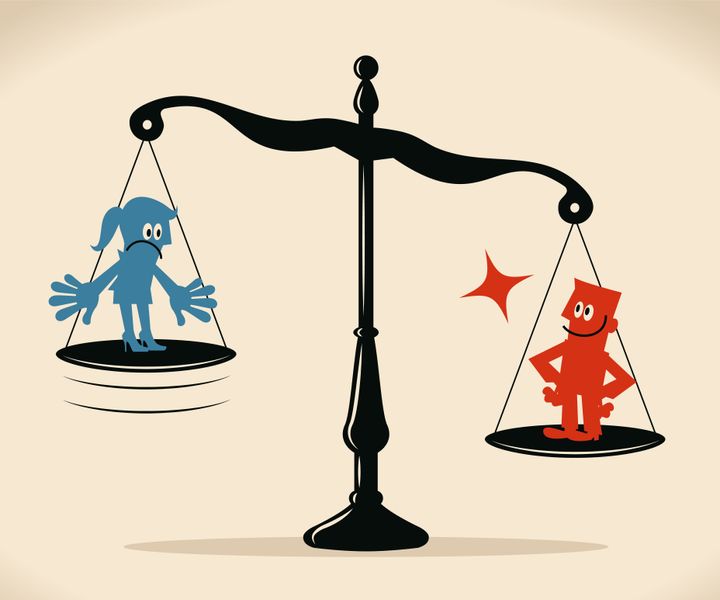
Today marks British Equal Pay Day – meaning from this day until December 31, the average women in the UK is effectively working for free.
As UK charity Fawcett Society notes, working women in the UK take home £574 less than men each month – that works out to £6,888 each year.
As the chancellor Jeremy Hunt prepares to deliver the Autumn Statement today, Jemima Olchawski, chief executive of the Fawcett Society, said: “The chancellor is delivering the Autumn Statement today, but can he really build a thriving economy without closing the gender pay gap?”
The group is calling to make flexible working the norm in both high-quality and high-paid jobs to help close the gender pay gap in the workplace.
The gender pay gap is very much a real thing – even female celebrities all over the world have to fight for equal pay. But, one in seven people in the UK think gender inequality “doesn’t really exist”.
So here are five key facts which prove this is still a pressing issue in the UK.
1. Women are working for free for the rest of 2023
As the pay gap is almost 15% – and only gets wider for women who have children – the average woman in paid employment effectively works for free for nearly two months of the year compared to the average man.
That’s according to the Trade Union Congress’s research released in February this year.
It found that the largest pay gap occurs for women aged between 50 and 59 who face a discrepancy of 20.8%. That means they work 76 days for free.
Geographically, the gender pay gap is largest for those in the South East of England, where women work 66 days for free.
And in terms of industry, education is the one with the largest pay gap of 22.2%, where the average woman effectively works for free for more than a fifth of the year – 81 days.
However, when looking at Fawcett Society’s research, it draws a wider conclusion that from November 22, in 2023, the average woman in the UK is effectively working for free for the rest of the year.
2. Gender pay equality is a long way off
Overall, the Fawcett Society found there has been a slight improvement in the UK’s gender pay gap, as it narrowed from 10.9% to 10.7%.
However, it still found the gender pay gap for British women who are born before 1983 won’t experience pay equality until they reach State Pension Age – meaning most will have left the workforce.
That means the gender pay gap is not predicted to close until 2051, according to Fawcett Society.
However, others have an even starker predictions.
A senior economist from PwC UK, Larice Stielow, claimed earlier this year that an 18-year-old woman going into the workforce in 2023 “won’t see pay equality in her working lifetime”, adding: “At the rate the gender pay gap is closing, it will take more than 50 years to reach gender pay parity.”
The UN also notes that at the current rate it will take 257 years for close the global gender pay gap, and women around the world still carry out at least 2.5 times more unpaid work than men.
3. Women typically have to take on lower-paid work
Women are more likely to take on flexible work – which is linked to lower pay or lower quality work.
As the Fawcett Society pointed out, women in the UK are also more likely to report working part-time (27%) compared to men (14%).
The International Workplace Group found in March that 72% of women would look for a new job if their employer took away the option for hybrid working.
4. UK has fallen in ranks monitoring women in the workplace
According to PwC’s annual OECD index of women’s employment outcomes, the UK has fallen five places when it comes to its efforts with women in the workplace.
That means it has dropped from 9th place to 14th in PwC’s rankings.
In fact, the Financial Times reported in April 80% of UK employers still have a gender pay gap for their employees – a higher rate compared to six years ago when reporting such discrepancy became compulsory.
Looking further afield, it’s worth noting that no country has achieved pay equity for women, according to the UN, which marks International Equal Pay Day on September 18.
5. The situation is even worse for women of colour
Race equality think tank Runnymede Trust found that the pay gap is much larger for women of colour when compared to the average white British man’s pay.
It found that Equal Pay Day came on September 14 for mixed white and Black Caribbean women (75 days of working for free).
For Pakistani and mixed white and Black African women, it was on September 25 (68 days).
For Bangladeshi women, it was on October 8 (58 days), for Black African women, it was October 16 (53 days).
This compared to November 22 (26 days of working for free) for all women in the UK.